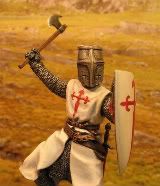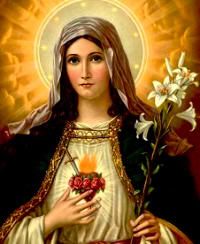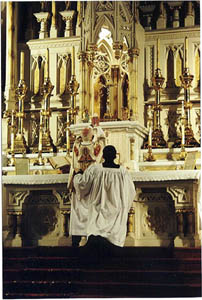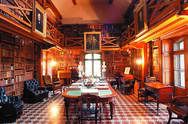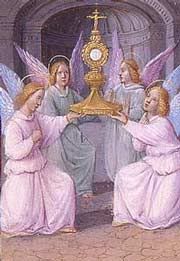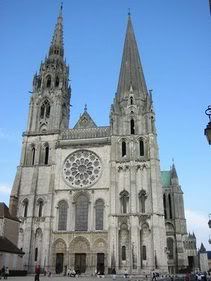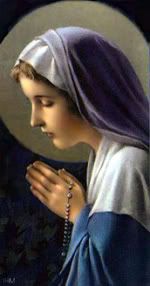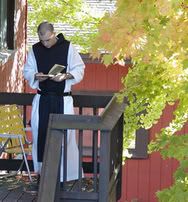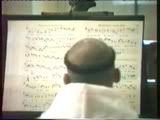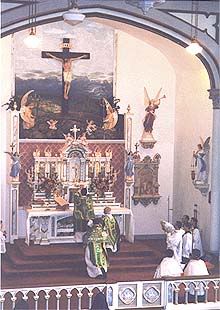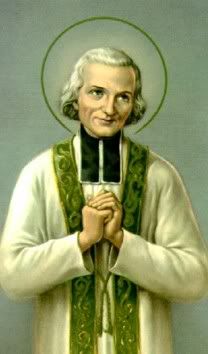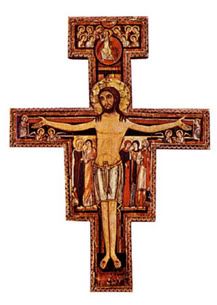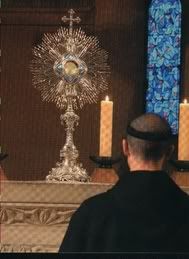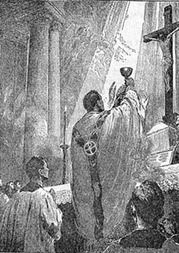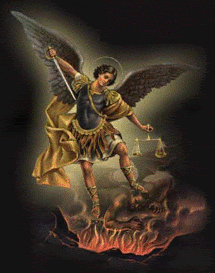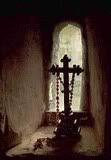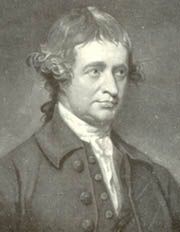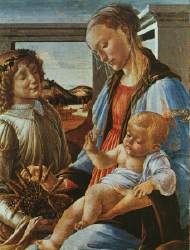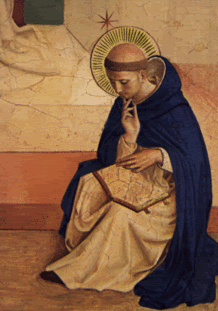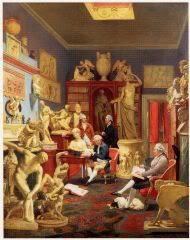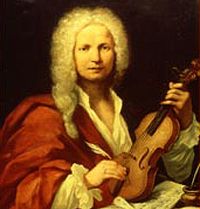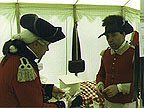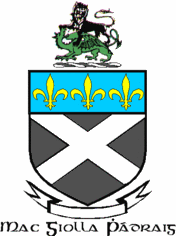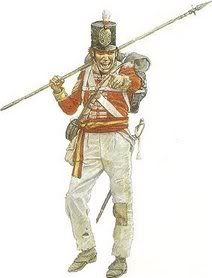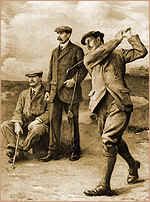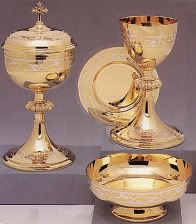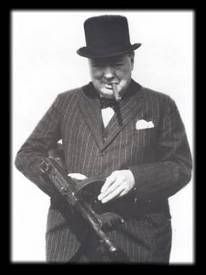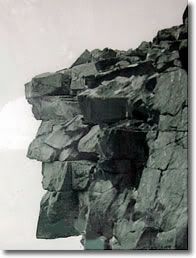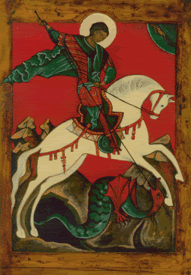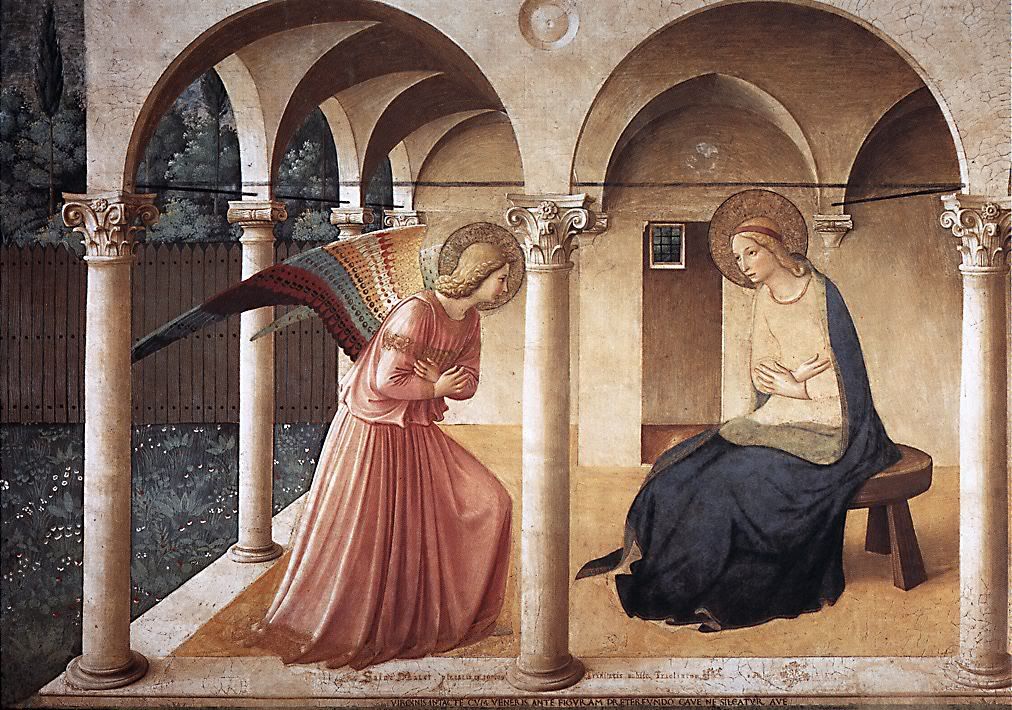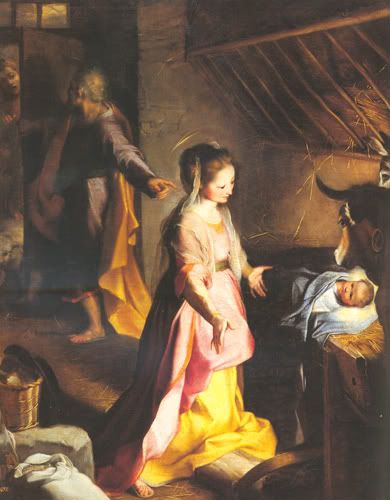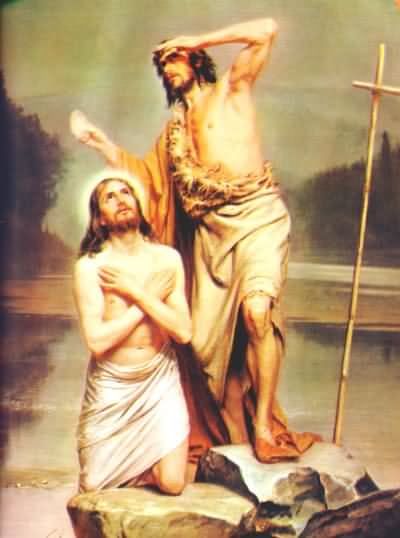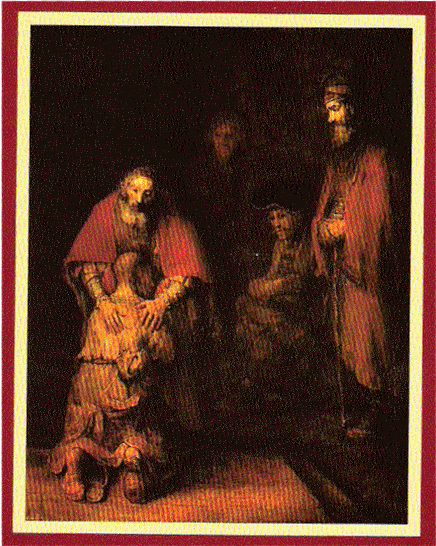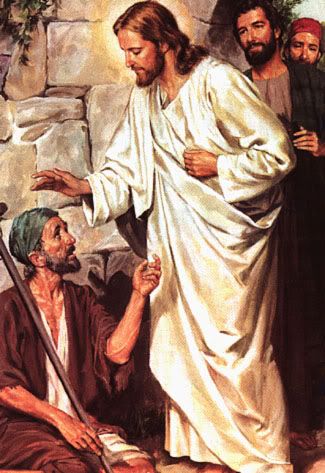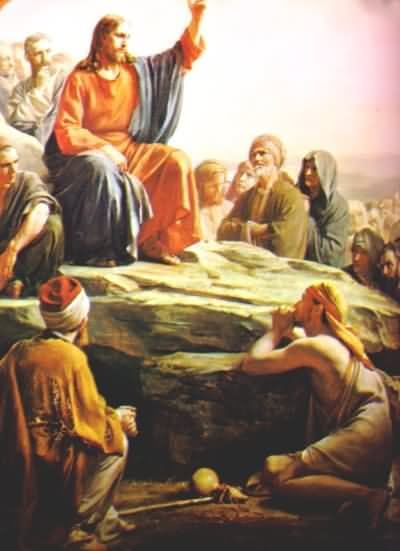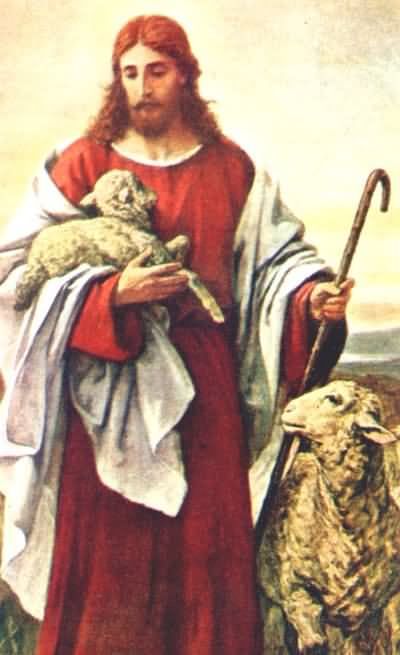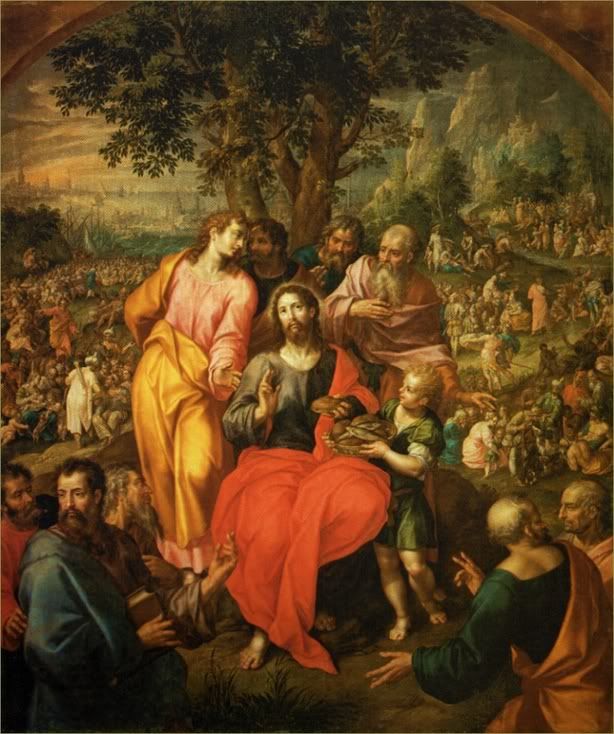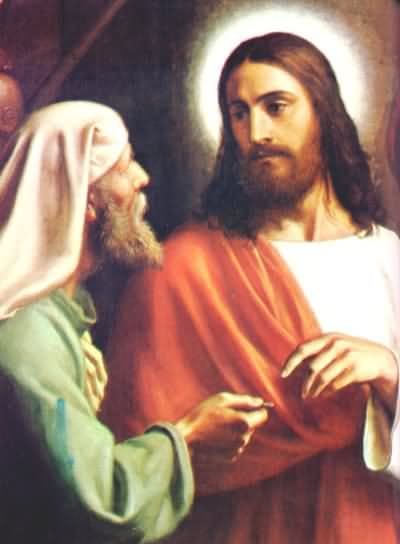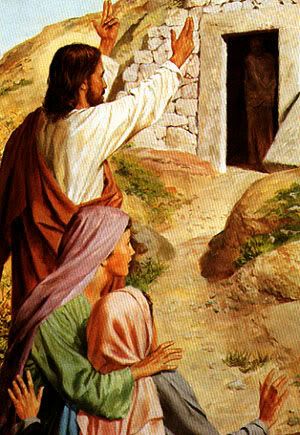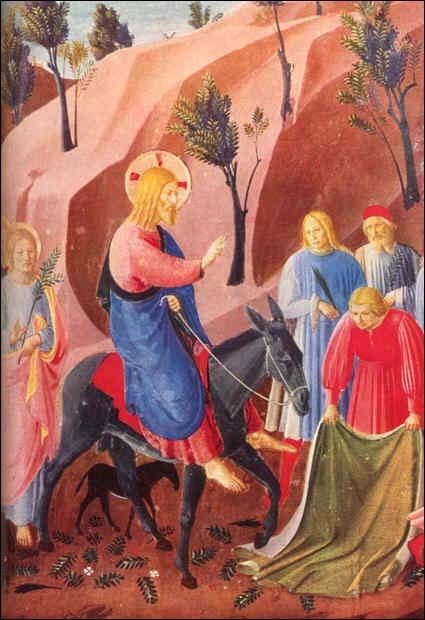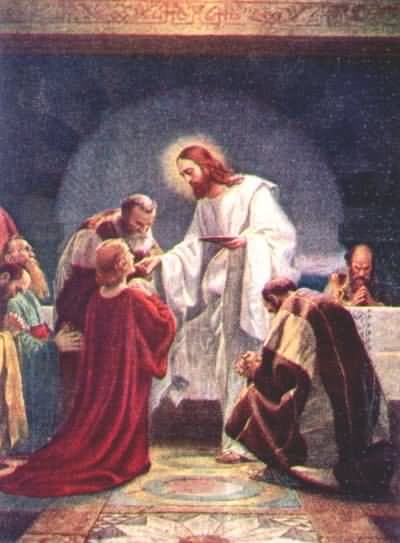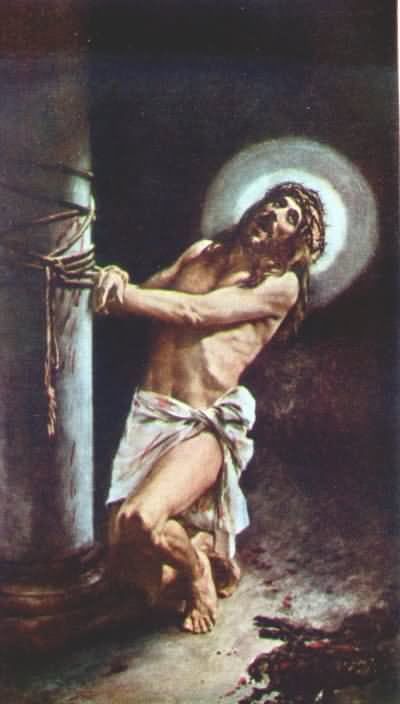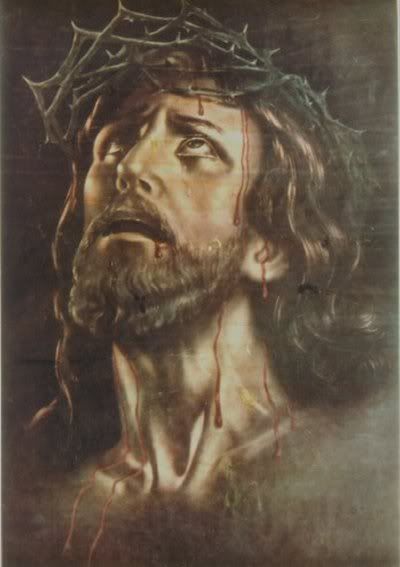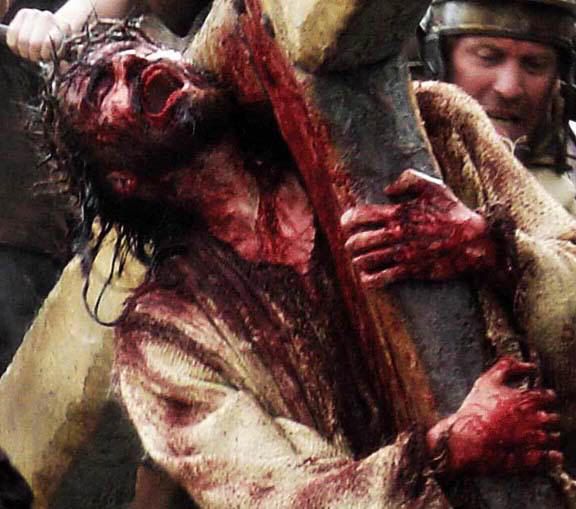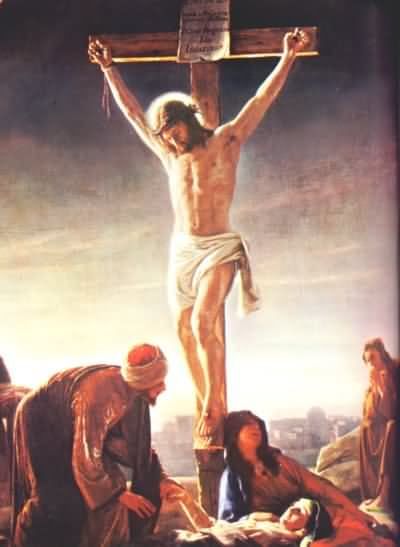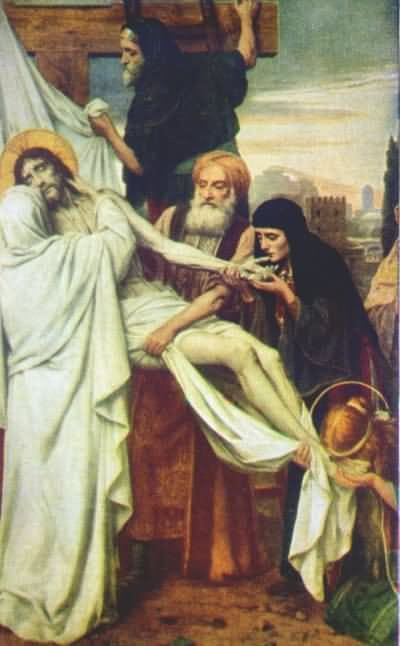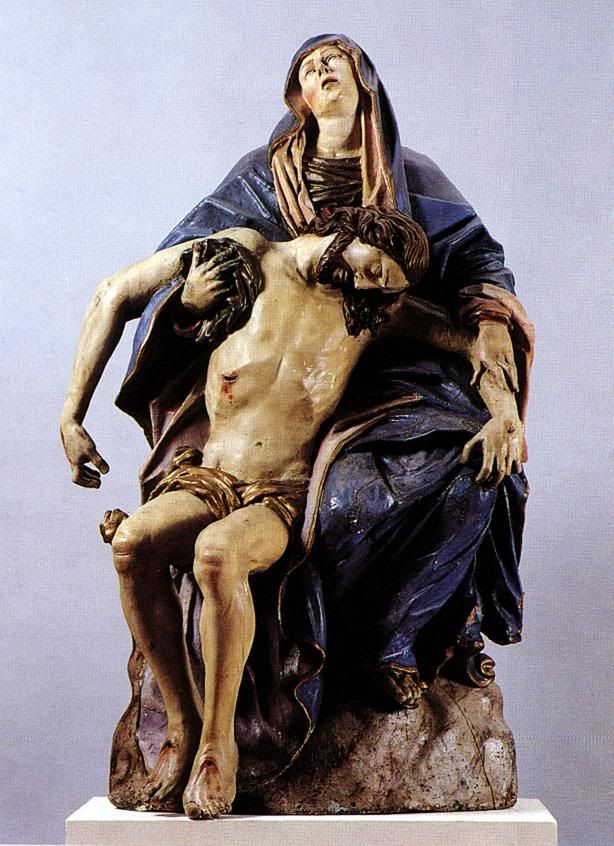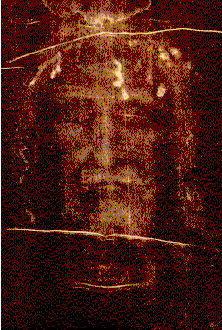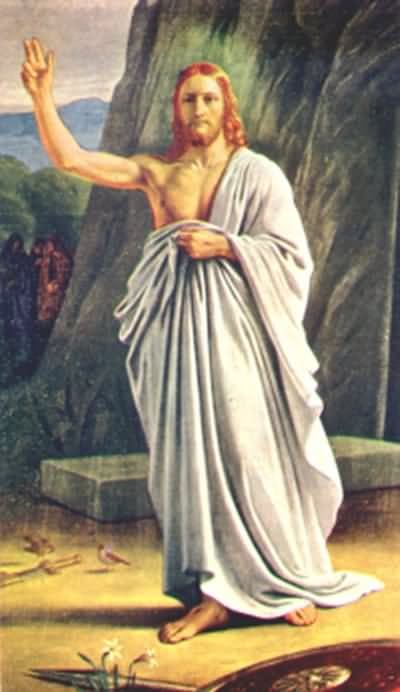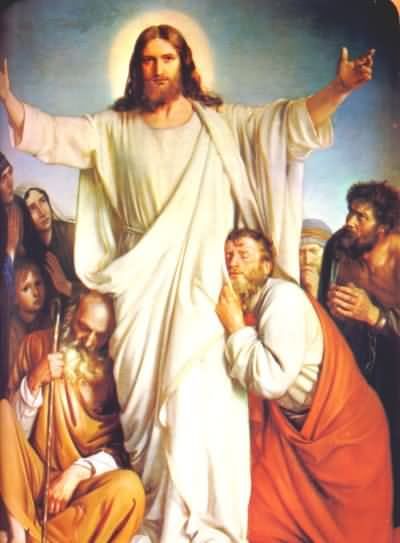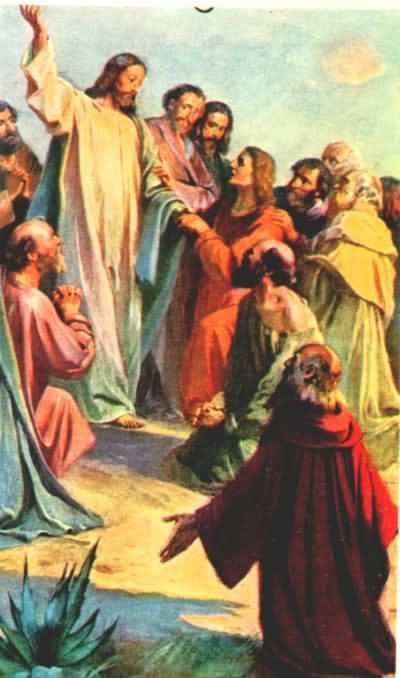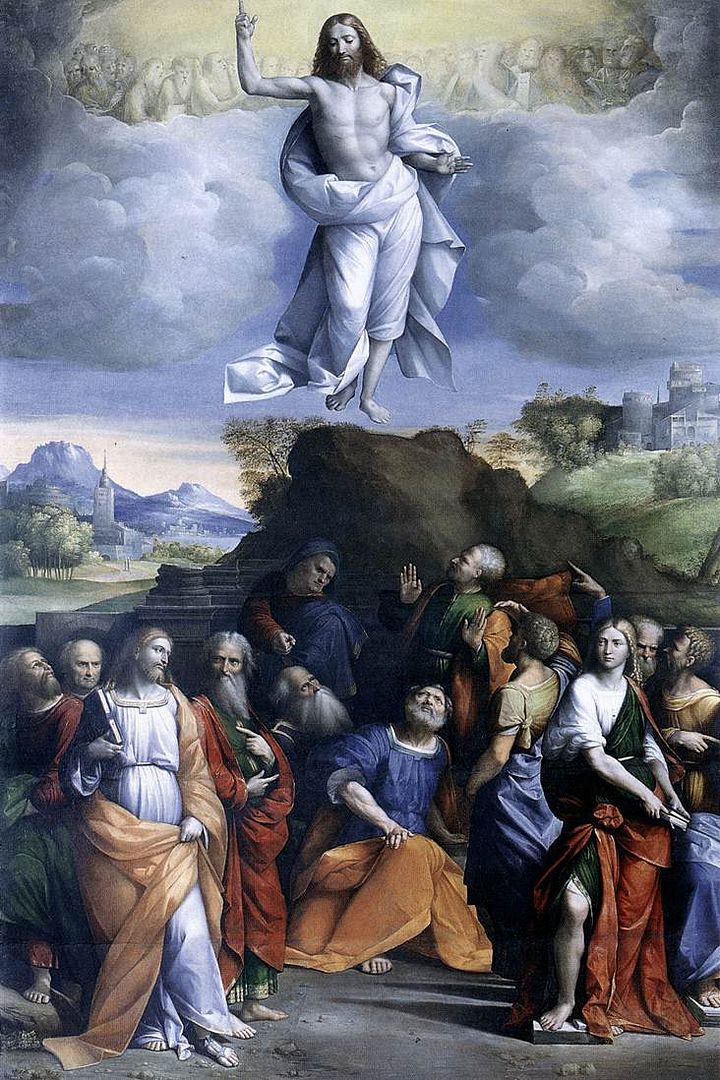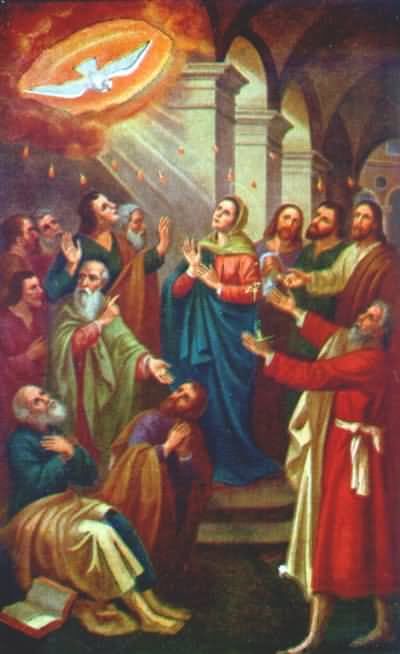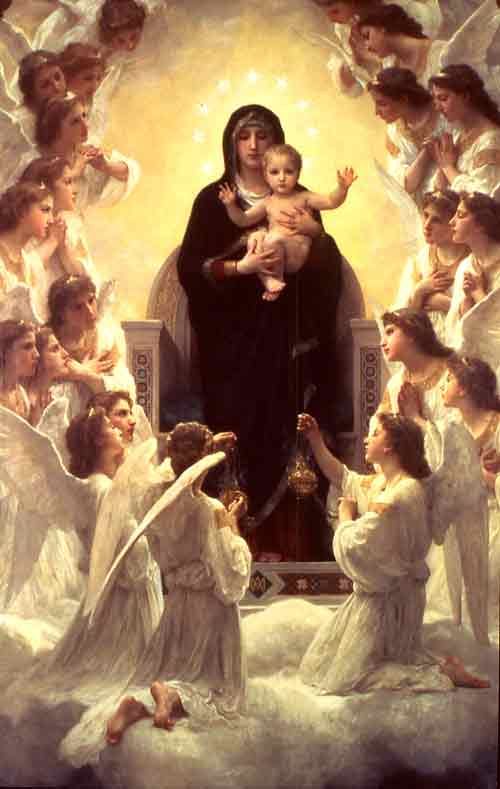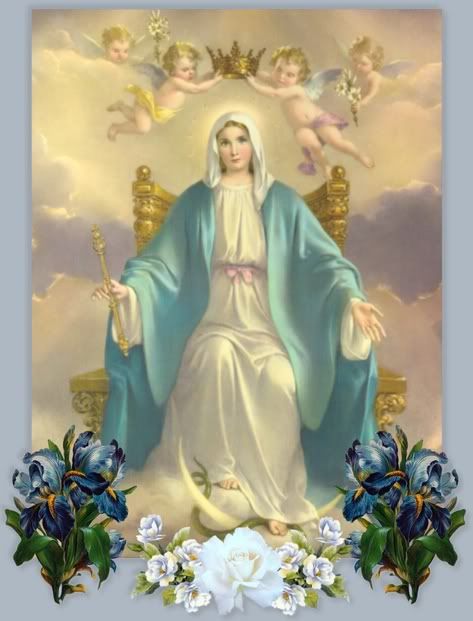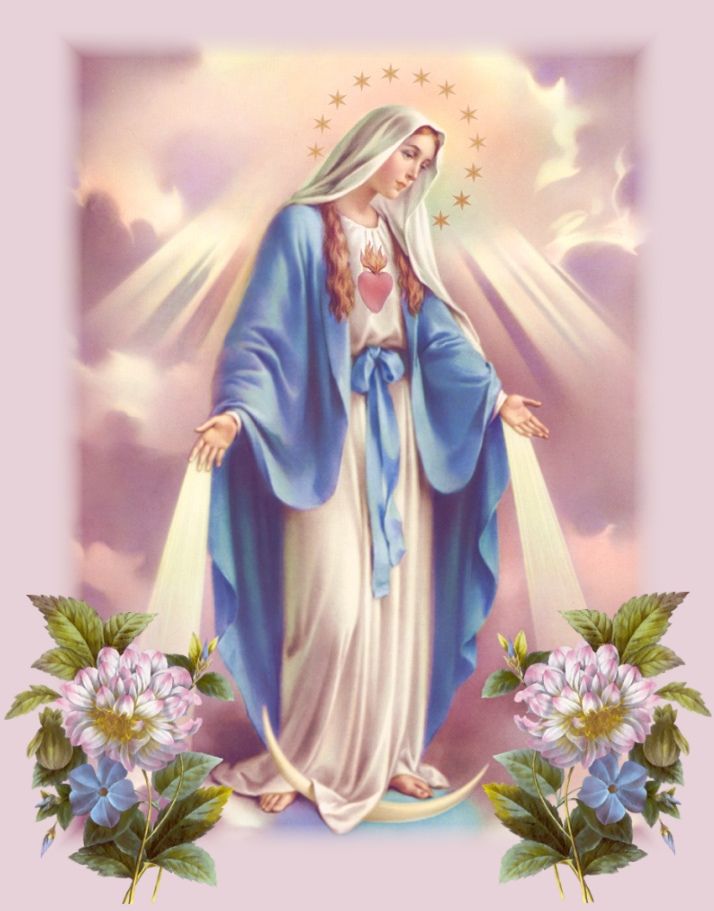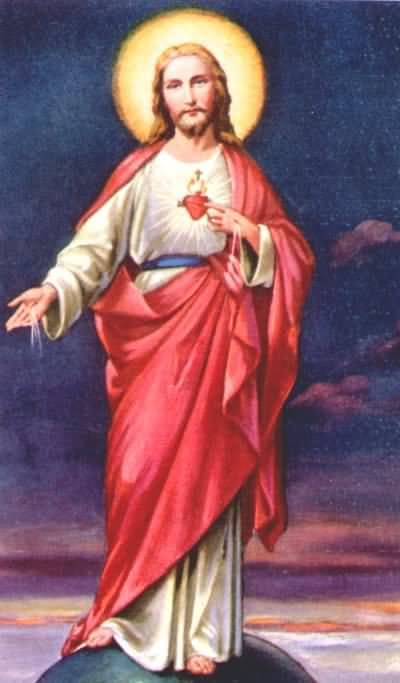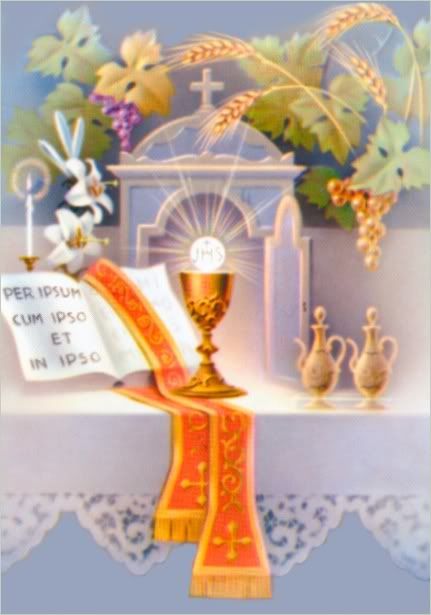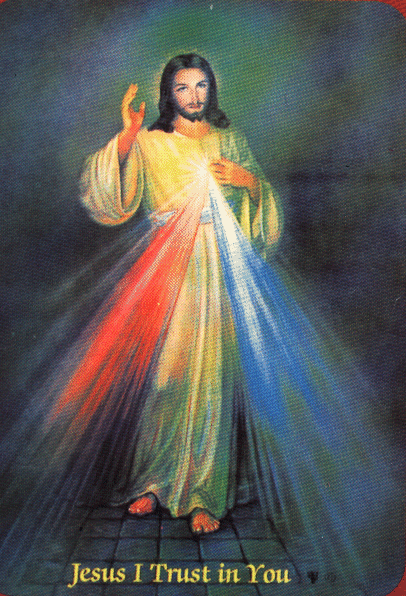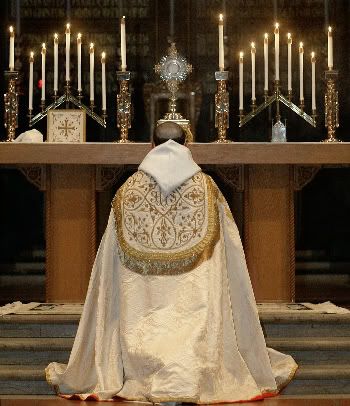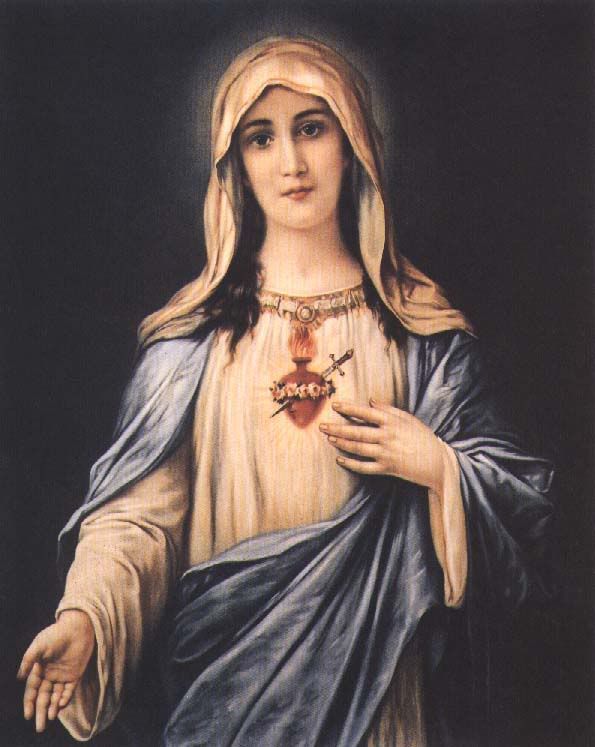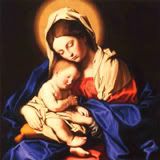Saturday, February 23, 2008
Something Different for Lent
If you, like me, give up meat for the entirety of Lent, then you, like me, will be getting tired of the seemingly endless succession of filet-o-fish, cheese pizza, tuna and egg salad, pretzels, macaroni and cheese, and peanut butter crackers.
On a whim, I tried something for an early lunch today, and found it very good. Naan is an Indian Tandoori flatbread made with ghee, which is clarified butter, and I found a 2-pack at Shaw's, for $2.99. On a whim, I picked it up, and bought some lemon hummus to dip it in. The Naan is like an exceptionally rich pita bread. And the lemon hummus gives it a sweetness that is very pleasing, and not cloying at all. And i washed it down the Vitamin Water's Rescue flavor, which is water flavored with green tea.
As a practical matter, I am not able to live on bread and water for the duration of Lent. I need some protein, and I need some flavor. Naan with lemon hummus was just the thing to change things up a bit, and break up the monotony of Lenten austerity, without transgressing against what I want to abstain from.
Try it.
On a whim, I tried something for an early lunch today, and found it very good. Naan is an Indian Tandoori flatbread made with ghee, which is clarified butter, and I found a 2-pack at Shaw's, for $2.99. On a whim, I picked it up, and bought some lemon hummus to dip it in. The Naan is like an exceptionally rich pita bread. And the lemon hummus gives it a sweetness that is very pleasing, and not cloying at all. And i washed it down the Vitamin Water's Rescue flavor, which is water flavored with green tea.
As a practical matter, I am not able to live on bread and water for the duration of Lent. I need some protein, and I need some flavor. Naan with lemon hummus was just the thing to change things up a bit, and break up the monotony of Lenten austerity, without transgressing against what I want to abstain from.
Try it.
Labels: Restorationists
Our Blessed Lady's Saturday

From The Foot Of the Cross, by Father Frederick W. Faber:
The Crucifixion can never be rightly understood without Mary, because without her it is not truthfully represented.
What a picture it is, the High Mass of the world's redemption, offered by Jesus to the Eternal Father, while the countless angels are the audience and the spectators! When the Host is elevated, the whole frame of inanimate nature trembles with terror and adoration, and earth darkens itself, which is to be a rubric it is to observe in the presence of Jesus for all ages.
But what is Mary's part? Her Immaculate Heart is the living Altar-stone on which the Sacrifice is offered; it is the Server, the beatings of whose broken heart are the responses of the liturgy; it is the Thurible, in which the world's faith, the world's hope, the world's love, the world's worship, are being burnt like incense before the slain Lamb that taketh away the sins of the world; and, finally, the same Immaculate Heart is the Choir; the more than angelic Choir of that tremendous Mass; for did not the silence of her beautiful sufferings sing unutterable, voiceless songs into the ravished ear of the Bleeding Host?
Labels: Restorationists
Saturday Of the Second Week In Lent
Station Church:
Ss. Marcellino e Pietro al Laterano
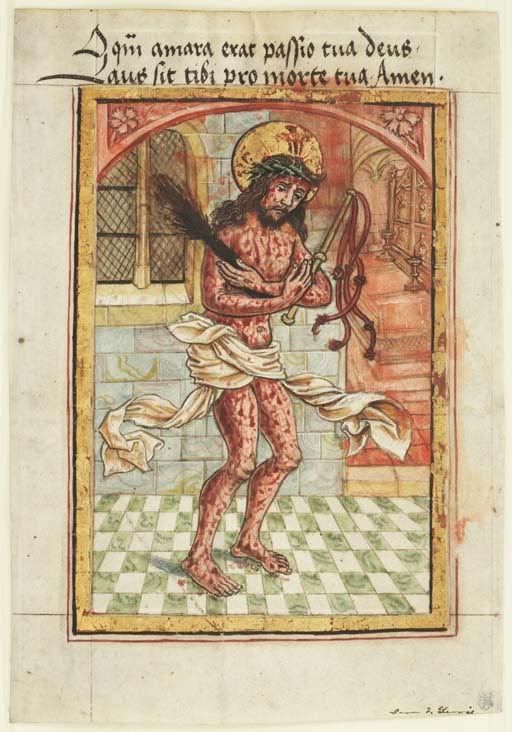
Devotions for a Lenten Saturday holy hour:
Divine Mercy Chaplet
Seven Penitential Psalms
Prayer of St. Thomas More
Threnus Prayer of Saint Augustine
Stabat Mater Dolorosa
Litany of Our Lady of Sorrows
Sorrowful Mysteries
Ss. Marcellino e Pietro al Laterano

Devotions for a Lenten Saturday holy hour:
Divine Mercy Chaplet
Seven Penitential Psalms
Prayer of St. Thomas More
Threnus Prayer of Saint Augustine
Stabat Mater Dolorosa
Litany of Our Lady of Sorrows
Sorrowful Mysteries
Labels: Restorationists
Friday, February 22, 2008
Battle Of Lexington Diorama
These two photos are from the diorama of the Battle of Lexington Green, housed in the Lexington Chamber of Commerce visitors' center next to the Buckman Tavern. The diorama was constructed for the Bicentennial, and was partially the work of Mr. William Buckley, the CIA officer kidnapped and murdered in Lebanon by Moslem terrorists two decades ago.
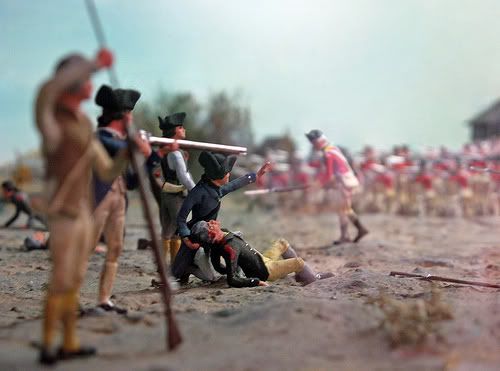



Labels: Toy Soldiers and Wargames
We're Having A Snowstorm
Boston is expected to end up with 6-8 inches, in what I would call a late-season snowstorm. Longtime readers will know how much I enjoy snow, ice, and so on, with my two trick knees, each of which has now dislocated 4 times, mostly due to slips on ice.
Oh well, at least the afternoon sunshine, when there is some, is extending later and later into the evening every day. And the Vernal Equinox is about a month away.
Oh well, at least the afternoon sunshine, when there is some, is extending later and later into the evening every day. And the Vernal Equinox is about a month away.
Labels: New England Things
Arma Christi
The "Arms of Christ," or "Arms of the Passion," is a stylized representation of all of the physical implements, or instruments that we know Our Lord came into contact with, saw, or otherwise played a part in His Passion. In most of the cases, they are the physical instruments of His Death, or tools used by those who brought it about.
Last year, I posted on Arma Christi images.
Since then, I have come across a few more, which I share now for your edification.

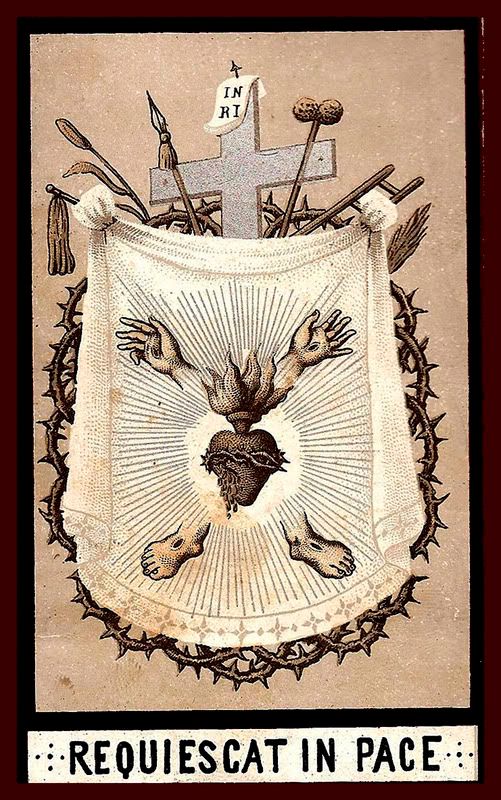
As you can see, these representations of the Arma Christi are often linked to the intense medieval devotion to the Five Sacred Wounds, and its own derivative devotion, that of the Sacred Heart.
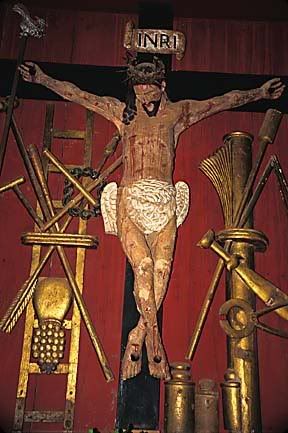
They are also frequently linked to a Crucifix, the one above from a Jesuit church in Brazil

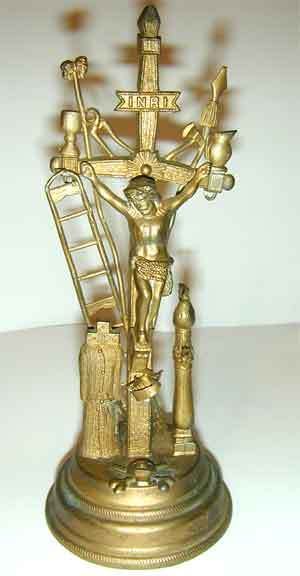
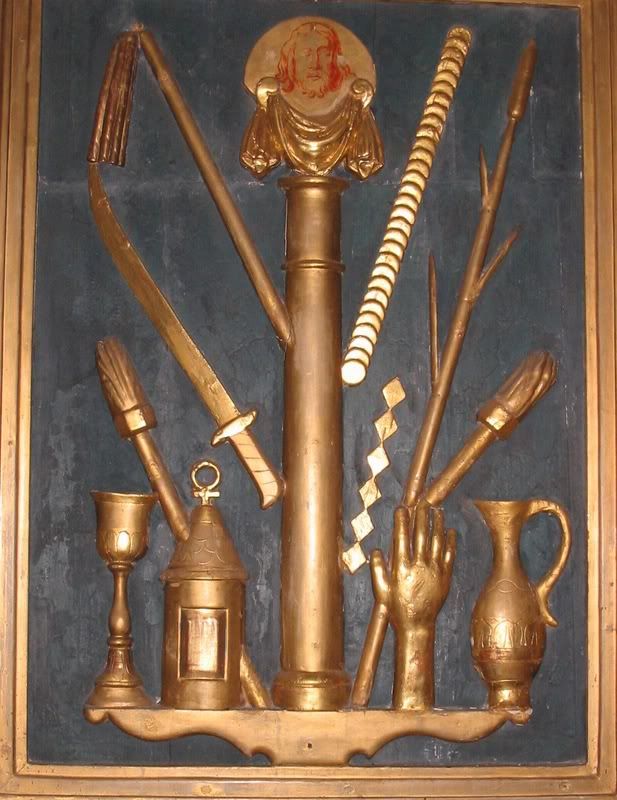
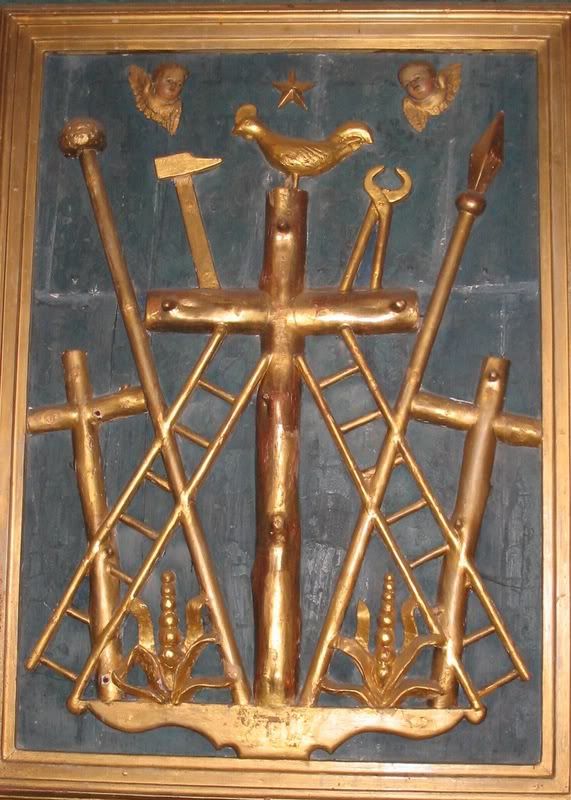
The Instruments of th ePassion often are depicted in medieval Books of Hours:
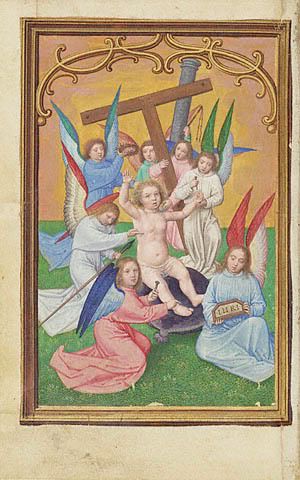

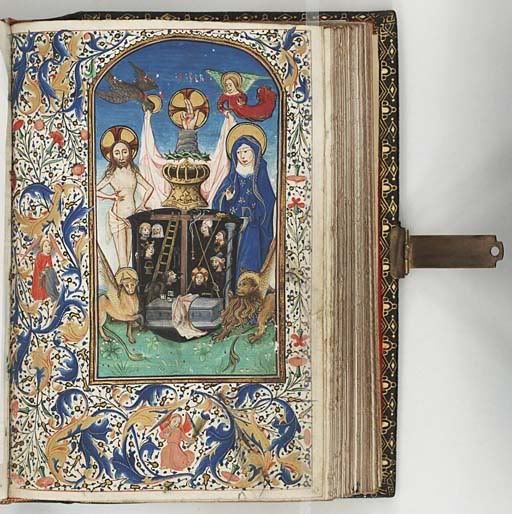
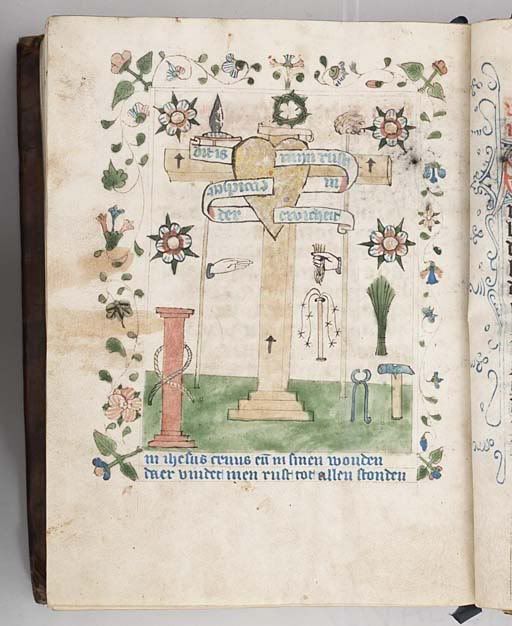
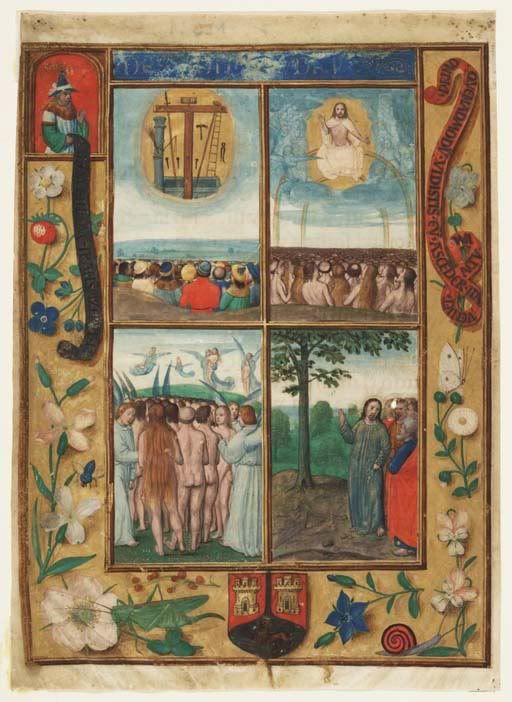
For further reading on the Instruments of the Passion, read this description of some of them from four priests, whose book was granted an Imprimatur in 1890.

Last year, I posted on Arma Christi images.
Since then, I have come across a few more, which I share now for your edification.


As you can see, these representations of the Arma Christi are often linked to the intense medieval devotion to the Five Sacred Wounds, and its own derivative devotion, that of the Sacred Heart.

They are also frequently linked to a Crucifix, the one above from a Jesuit church in Brazil




The Instruments of th ePassion often are depicted in medieval Books of Hours:





For further reading on the Instruments of the Passion, read this description of some of them from four priests, whose book was granted an Imprimatur in 1890.

Labels: Restorationists
Friday At the Foot Of the Cross
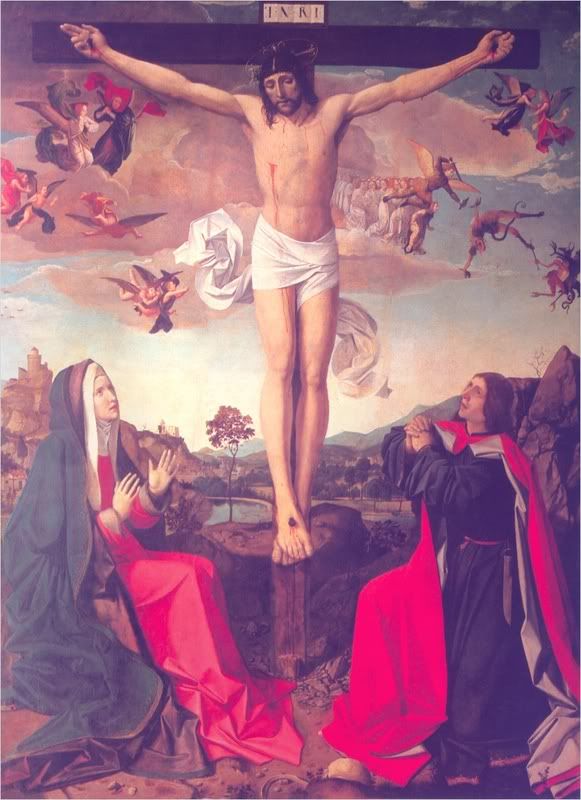
From The Passion And Death of Jesus Christ, by Saint Alphonsus Liguori:
"Woman, behold thy son . . . Behold thy mother." [John 19: 26, 27]
We read in St. Mark [15: 40] that on Calvary there were present many women, who watched Jesus on the Cross, but from afar off, among whom was Mary Magdalen. We believe, also, that among these holy women was the Divine mother also; while St. John says that the Blessed Virgin stood, not afar off, but close to the Cross, together with Mary of Cleophas and Mary Magdalen. [John 19: 25] Euthymius attempts to reconcile this discrepancy, and says that the Holy Virgin, seeing her son drawing nearer to death, came from among the rest of the women close up to the Cross, overcoming her fear of the soldiers who surrounded it, and enduring with patience all the insults and repulses which she had to suffer from these soldiers who watched the condemned, in order that she might draw near her beloved Son. Thus also a learned author, who wrote the life of Jesus Christ, says, "There were His friends, who watched Him from afar; but the Holy Virgin, the Magdalen, and another Mary stood close to the Cross, with John; wherefore Jesus, seeing His mother and John, spoke to them the words above mentioned. Truly it was the mother who not even in the terror of death deserted her Son. Some other mothers fly when they see their children dying; their love does not suffer them to be present at their death without the power of relieving them; but the holy mother, the nearer her Son approached to death, the nearer she drew to His Cross."
The afflicted mother thus was standing close to the Cross; and as the Son. sacrificed His life, so she offered her pangs for the salvation of men, sharing with perfect resignation all the pains and insults which her Son suffered in His death. A writer says that they who would describe her fainting at the foot of the Cross dishonor the constancy of Mary. She was the strong woman, who neither fainted nor wept, as St. Ambrose writes: "I read of her standing, but not of her weeping." The pain which the Holy Virgin endured in the Passion of her Son exceeded all the pains which a human heart can endure; but the grief of Mary was not a barren grief, like that of other mothers who behold the sufferings of their children; it was a fruitful grief, since through the merits of her so great grief, and through her love [according to the opinion of St. Augustine], as she was the natural mother of our head Jesus Christ, so she then became the spiritual mother of us who are His faithful members, in co-operating with Him by her love in causing us to be born, and to be the children of the Church.
St. Bernard writes that upon Mount Calvary both of these two great Martyrs, Jesus and Mary, were silent, because the great pain that they endured took from them the power of speaking. The mother looked upon her Son in agony upon the Cross, and the Son looked upon the mother in agony at the foot of the Cross, and torn with compassion for the pains He suffered.
Mary and John then stood nearer to the Cross than the other women, so that they could more easily hear the words and mark the looks of Jesus Christ in so great a tumult. St. John writes: When Jesus then saw His mother and the disciple standing, whom He loved, he saith to His mother: Woman, behold thy son. [John 19: 26] But if Mary and John were accompanied by other women, why is it said that Jesus beheld His mother and the disciple, as if the other women had not been perceived by Him? St. John Chrysostom writes that love always makes us look more closely at the object of our love. And St. Ambrose in a similar way writes, It is natural that we should see those we love before any others. The Blessed Virgin revealed to St. Bridget that in order that Jesus might look upon Mary, who stood by the side of the Cross, He was obliged first to compress his eyebrows in order to remove the blood from His eyes, which prevented Him from seeing.
Jesus said to her, Woman, behold thy son! with His eyes pointing out St. John, who stood by His side. But why did He call her woman, and not mother? He called her "woman," we may say, because, drawing now near to death, He spoke as if departing from her, as if He had said, Woman, in a little while I shall be dead, and thou wilt have no Son upon earth; I leave thee, therefore, John, who will serve and love thee as a son. And from this we may understand that St. Joseph was already dead, since if he had been still alive he would not have been separated from his wife.
All antiquity asserts that St. John was ever a virgin, and specially on this account he was given as a son to Mary, and honored in being made to occupy the place of Jesus Christ; on which account the holy Church sings, "To him a virgin He commended His Virgin Mother." And from the moment of the Lord's death, as it is written, St. John received Mary into his own house, and assisted and obeyed her throughout her life, as if she had been his own mother. [John 19: 27] Jesus Christ willed that this beloved disciple should be an eye-witness of His death, in order that he might more confidently bear witness to it in his Gospel, and might say, He that saw it has borne witness; [John 19: 35] and in his Epistle, What we have seen with our eyes, that we both testify and make known to you.
[John 1: 1]
And on this account the Lord, at the time when the other disciples abandoned Him, gave to St. John strength to be present until His death in the midst of so many enemies.
But let us return to the holy Virgin, and examine more deeply the reason why Jesus called Mary woman, and not mother. By this expression He desired to show that she was the great woman foretold in the Book of Genesis, who would crush the serpent's head: I will put enmities between thee and the woman, and thy seed and her seed: she shall crush thy head, and thou shalt lie in wait for her heel. [Genesis 3: 15] It is doubted by none that this woman was the Blessed Virgin Mary, who, by means of her Son, would crush the head of Satan,------if it be not more correct to say that her Son, by means of her who would bear Him, would do this. Naturally was Mary the enemy of the serpent, because Lucifer was haughty, ungrateful, and disobedient, while she was humble, grateful, and obedient. It is said, She shall crush thy head, because Mary, by means of her Son, beat down the pride of Lucifer, who lay in wait for the heel of Jesus Christ, which means His holy humanity, which was the part of Him which was nearest to the earth; while the Savior by His death had the glory of conquering him, and of depriving him of that empire which, through sin, he had obtained over the human race.
God said to the serpent, I will put enmities between thy seed and the woman. This shows that after the fall of man, through sin, notwithstanding all that would be done by the redemption of Jesus Christ, there would be two families and two posterities in the world, the seed of Satan signifying the family of sinners, his children corrupted by him, and the seed of Mary, signifying the holy family, which includes all the just, with their head Jesus Christ. Hence Mary was destined to be the mother both of the head and of the members, namely, the faithful. The Apostle writes: Ye are all one in Christ Jesus; and if ye are Christ's, then ye are the seed of Abraham. [Galatians 3: 28] Thus, Jesus Christ and the faithful are one single body, because the head cannot be divided from the members, and these members are all spiritual children of Mary, as they have the same spirit of her Son according to nature, Who was Jesus Christ. Therefore, St. John was not called John, but the disciple beloved by the Lord, that we might understand that Mary is the mother of every good Christian who is beloved by Jesus Christ, and in whom Jesus Christ lives by His Spirit. This was expressed by Origen, when he said, "Jesus said to Mary, Behold thy son, as if he had said, This is Jesus, Whom thou hast borne, for He who is perfected lives no more himself, but Christ lives in him."
Denis the Carthusian writes that in the Passion of Jesus Christ the breast of Mary was filled with the Blood which flowed from His Wounds, in order that with it she might nourish her children. And he adds that this Divine mother by her prayers and merits, which she especially acquired by sharing in the death of Jesus Christ, obtained for us a participation in the merits of the Passion of the Redeemer."
O suffering Mother! Thou knowest that I have deserved Hell; I have no hope of being saved, except by sharing the merits of the death of Jesus Christ; Thou must pray for me, that I may obtain this grace; and I pray thee to obtain it for me by the love of that Son Whom thou sawest bow His head and expire on Calvary before thy eyes. O queen of Martyrs, O advocate of sinners, help me always, and especially in the hour of my death! Even now I seem to see the devils, who, in my last agony, will strive to make me despair at the sight of my sins; oh! abandon me not then, when thou seest me thus assaulted; help me with thy prayers, and obtain for me confidence and holy perseverance. And because then, when my speech is gone, and perhaps my senses, I cannot invoke thy name, and that of thy Son, I now call upon thee; Jesus and Mary, I recommend my soul unto You.
Labels: Restorationists
Friday Of the Second Week In Lent
Station Church:
S. Vitale in Fovea

Devotions For A Lenten Friday Holy Hour:
Dies Irae
Divine Mercy Chaplet
Seven Penitential Psalms
Prayer of St. Thomas More
Threnus Prayer of Saint Augustine
Devotions To the Holy Cross
Stations of the Cross
S. Vitale in Fovea

Devotions For A Lenten Friday Holy Hour:
Dies Irae
Divine Mercy Chaplet
Seven Penitential Psalms
Prayer of St. Thomas More
Threnus Prayer of Saint Augustine
Devotions To the Holy Cross
Stations of the Cross
Labels: Restorationists
Thursday, February 21, 2008
The Holy Father's Revised Prayer For the Jewish People and the SSPX
A very interesting discussion at Father Z's.
I think the SSPX's failure to obediently accept this change to the Missal they use is a very sad signal that they are not in any way ready to reciprocate good will and obedience for good will from Rome.
I would urge any obedient Catholics who might be attending SSPX chapels this Good Friday in order to have the full traditional Good Friday Veneration of the Cross, to silently, and without show, pray the Holy Father's revision, rather than what the SSPX congregation is praying.
I just printed it out, and inserted it in my own Missal.
I think the SSPX's failure to obediently accept this change to the Missal they use is a very sad signal that they are not in any way ready to reciprocate good will and obedience for good will from Rome.
I would urge any obedient Catholics who might be attending SSPX chapels this Good Friday in order to have the full traditional Good Friday Veneration of the Cross, to silently, and without show, pray the Holy Father's revision, rather than what the SSPX congregation is praying.
I just printed it out, and inserted it in my own Missal.
Labels: Restorationists
An Inspiration
I was thinking the other day about the number of images of Our Lord as The Man of Sorrows that I have stored away. Whether you call it the Image of Pity, the Man of Sorrows, the Ecce Homo, or anything else, the image of Our Lord crowned with thorns and held up to ridicule as a mock king is a staple in Catholic devotional art.
I have gone back to Ash Wednesday in my posts, and added an image of the Man of Sorrows to each day (except Sundays) right under the Station Church. I just wish I had thought of this sooner, as it provides a way to share this little collection culled from the net with everyone.
I have gone back to Ash Wednesday in my posts, and added an image of the Man of Sorrows to each day (except Sundays) right under the Station Church. I just wish I had thought of this sooner, as it provides a way to share this little collection culled from the net with everyone.
Labels: Restorationists
The Co-Incidence of St. Patrick's Day and Holy Week Is Causing Problems
The annual South Boston St. Patrick's Day Parade is scheduled for Palm Sunday. The saint's feast itself falls on the Monday of Holy Week, and therefore is liturgically superceded.
But Irishmen will have their drunken revelry for St. Patrick's Day, no matter when it falls.
We can be thankful that it does not fall during the Triduum, when all secular merry-making ought to be suppressed.
But Irishmen will have their drunken revelry for St. Patrick's Day, no matter when it falls.
We can be thankful that it does not fall during the Triduum, when all secular merry-making ought to be suppressed.
Labels: New England Things
Thursday Of the Second Week In Lent
Station Church: S. Maria in Trastevere

Devotions for a Lenten Thursday holy hour:
Dies Irae
Divine Mercy Chaplet
Seven Penitential Psalms
Prayer of St. Thomas More
Threnus Prayer of Saint Augustine
Devotion To the Holy Face

Devotions for a Lenten Thursday holy hour:
Dies Irae
Divine Mercy Chaplet
Seven Penitential Psalms
Prayer of St. Thomas More
Threnus Prayer of Saint Augustine
Devotion To the Holy Face
Labels: Restorationists
Wednesday, February 20, 2008
Things To Put You In Mind Of Our Lord's Suffering
The movie The Passion of the Christ, which depicted in the most realistic fashion yet, the corporal suffering of Our Lord in His Passion, elicited spontaneous displays of emotion in many who saw it. Many burst into tears, or at least found the eyes moistening. Some spontaneously confessed crimes and sins that they had even hidden from their confessors for years. At least one person confessed to a murder after seeing the suffering of Our Lord so depicted.
Oscar Wilde might have laughed at it, had he been alive, but few others could.
The movie put us directly in the line of sight of what actually happened to Jesus of Nazareth on the first Good Friday. And it reminded us that He suffered all that directly because of our sins. Your sins, my sins, everybody's sins. But it is best to personalize. You get more out of it that way. He underwent all that suffering because of my sinfulness, and in order to buy me back ("redeem me") from Satan.
Now just about everybody reading this blog probably has a DVD of The Passion of the Christ. The only people who probably don't are those who are eschewing all forms of passive media stimulation, and don't even own a television.
What is the next step, you say? How do you bring the meaning of His suffering into your life directly during this season of Lent? How can I be reminded this Lent of what He suffered for me?
Here are a few suggestions.
First, obtain an authentic, life-sized crown of thorns. Clear off your coffee table, or a place on your dining table, or your home altar, and put this crown of thorns there. Looking at this wicked instrument of cruelty on a regular basis will remind you of the enormous price He paid for you.
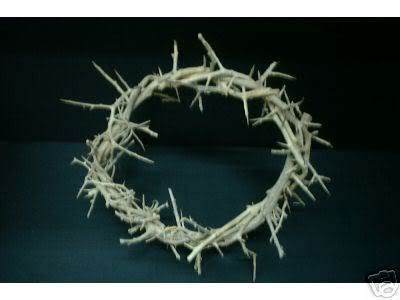
Similarly, replicas of the Nails of the Crucifixion perhaps placed with the Crown of Thorns, perhaps in another location, also help to remind us of what He underwent. This site sells a set of 2 five-inch nails, and one seven inch nail for about $80.00. Shop around on the Net, and you might find a better price, as that seems a little high to me.
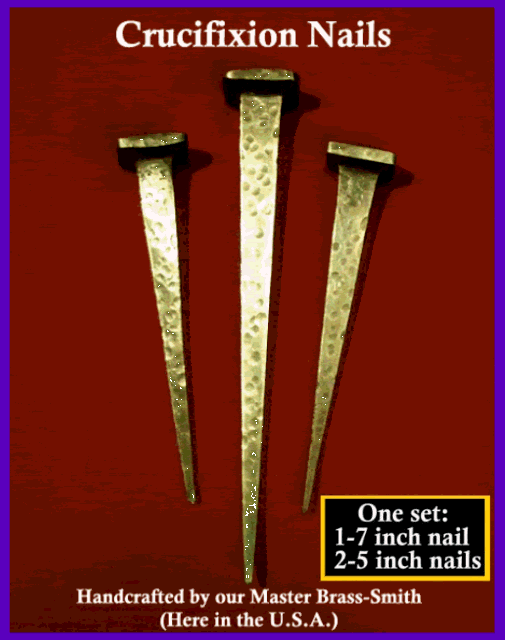
A final suggestion is that you obtain a moderate-sized Crucifix, and respectfully and reverently repaint it to represent the true Wounds of Our Lord, as evidenced by the Holy Shroud of Turin. You don't need to be Rembrandt to pull this off. I have done about 5 such Crucifixes in the last year. I carry one around with me daily, as I use it in my daily prayer (shamefully, the Chapel where I make my morning Holy Hour lacks a Crucifix, unless you count the Twelfth Station Of the Cross). The Crucifixes only cost me $7-$10, and paints and brushes an additional $20 or so.
A good guide is the Crucifix at St. Peter's Church in Harper's Ferry VA, which I featured yesterday. Or, if you are truly skilled, try your hand at replicating the wounds seen in The Passion Of the Christ, where you see not just the marks of the scourging, and Blood pouring from the principle nail wounds, but also the torn flesh and the bruising caused by the numerous beatings and blows, kicks and prods, etc.
I am always astonished that so many Crucifixes fail to depict these injuries. Do people think that the cruel whipping He endured left no marks, or that the torn Flesh miraculously healed on the way to Golgotha? No, indeed, the wounds would have been made worse, been added to, have re-opened to the extent that any had even begun to heal.
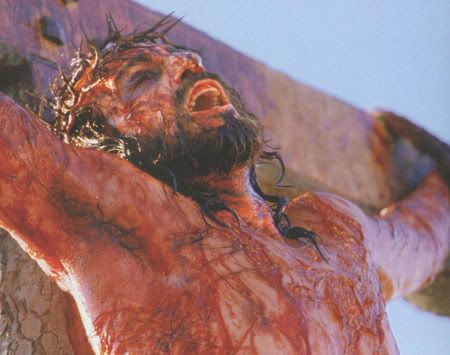
This Lent, truly take to heart Pilate's command. "Ecce Homo." Behond the man, and His suffering in its fullest extent. Then we can appreciate what He went through, and that will make us ever more sorry for our sins.
I have just begun St. Alphonsus Liguori's The Passion and Death of Jesus Christ, and I have already been struck by the wisdom, which he repeats, of Saint Augustine, that there is no more beneficial exercise for the soul than to contemplate His Most Bitter Passion. It is the most profitable spiritual exercise, and one everyone can do.
These are just means: the Crown of Thorns on the coffee table, the Nails of the Crucifixion on the home altar, the bloodied and goried Crucifix. The end is a more fruitful contemplation of His Passion. And that leads us to the true meaning of Lent, a deep awareness of His Suffering, and its cause, which is my sins (and yours) and a determination to confess them, and sin no more.
Oscar Wilde might have laughed at it, had he been alive, but few others could.
The movie put us directly in the line of sight of what actually happened to Jesus of Nazareth on the first Good Friday. And it reminded us that He suffered all that directly because of our sins. Your sins, my sins, everybody's sins. But it is best to personalize. You get more out of it that way. He underwent all that suffering because of my sinfulness, and in order to buy me back ("redeem me") from Satan.
Now just about everybody reading this blog probably has a DVD of The Passion of the Christ. The only people who probably don't are those who are eschewing all forms of passive media stimulation, and don't even own a television.
What is the next step, you say? How do you bring the meaning of His suffering into your life directly during this season of Lent? How can I be reminded this Lent of what He suffered for me?
Here are a few suggestions.
First, obtain an authentic, life-sized crown of thorns. Clear off your coffee table, or a place on your dining table, or your home altar, and put this crown of thorns there. Looking at this wicked instrument of cruelty on a regular basis will remind you of the enormous price He paid for you.

Similarly, replicas of the Nails of the Crucifixion perhaps placed with the Crown of Thorns, perhaps in another location, also help to remind us of what He underwent. This site sells a set of 2 five-inch nails, and one seven inch nail for about $80.00. Shop around on the Net, and you might find a better price, as that seems a little high to me.

A final suggestion is that you obtain a moderate-sized Crucifix, and respectfully and reverently repaint it to represent the true Wounds of Our Lord, as evidenced by the Holy Shroud of Turin. You don't need to be Rembrandt to pull this off. I have done about 5 such Crucifixes in the last year. I carry one around with me daily, as I use it in my daily prayer (shamefully, the Chapel where I make my morning Holy Hour lacks a Crucifix, unless you count the Twelfth Station Of the Cross). The Crucifixes only cost me $7-$10, and paints and brushes an additional $20 or so.
A good guide is the Crucifix at St. Peter's Church in Harper's Ferry VA, which I featured yesterday. Or, if you are truly skilled, try your hand at replicating the wounds seen in The Passion Of the Christ, where you see not just the marks of the scourging, and Blood pouring from the principle nail wounds, but also the torn flesh and the bruising caused by the numerous beatings and blows, kicks and prods, etc.
I am always astonished that so many Crucifixes fail to depict these injuries. Do people think that the cruel whipping He endured left no marks, or that the torn Flesh miraculously healed on the way to Golgotha? No, indeed, the wounds would have been made worse, been added to, have re-opened to the extent that any had even begun to heal.

This Lent, truly take to heart Pilate's command. "Ecce Homo." Behond the man, and His suffering in its fullest extent. Then we can appreciate what He went through, and that will make us ever more sorry for our sins.
I have just begun St. Alphonsus Liguori's The Passion and Death of Jesus Christ, and I have already been struck by the wisdom, which he repeats, of Saint Augustine, that there is no more beneficial exercise for the soul than to contemplate His Most Bitter Passion. It is the most profitable spiritual exercise, and one everyone can do.
These are just means: the Crown of Thorns on the coffee table, the Nails of the Crucifixion on the home altar, the bloodied and goried Crucifix. The end is a more fruitful contemplation of His Passion. And that leads us to the true meaning of Lent, a deep awareness of His Suffering, and its cause, which is my sins (and yours) and a determination to confess them, and sin no more.
Labels: Restorationists
Cilices, Hairshirts, and the Discipline
One stop shopping for all of your corporal mortification of the flesh needs. How thoughtful!

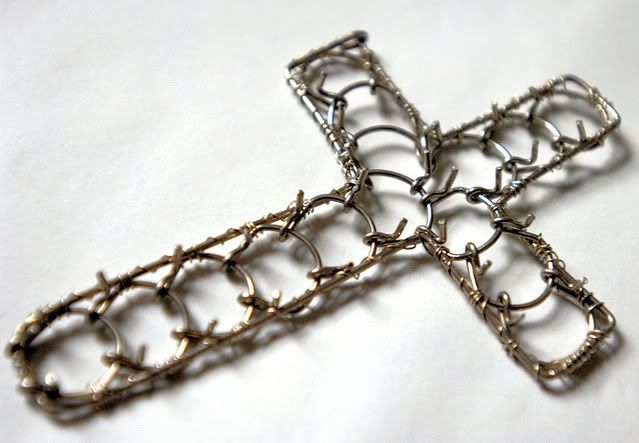
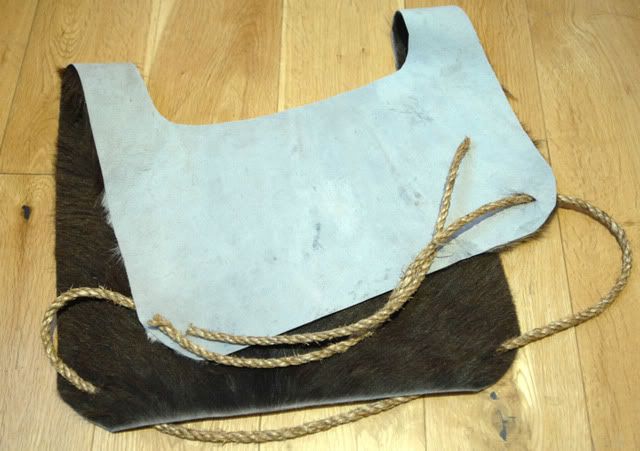
There might be an outside chance I could do the hairshirt. After all, many saints have worn them, and even Pope Paul VI wore one. I could probably be persuaded to wear one of the hairshirt cilice belts for three hours on a Friday in Lent, as it is just a belt made of sackcloth worn around the thigh. After all, I recognize my sinfulness, and the need for some form of mortification. It would be uncomfortable, but not break the skin or draw blood. But the other items, no thanks, not for me.




There might be an outside chance I could do the hairshirt. After all, many saints have worn them, and even Pope Paul VI wore one. I could probably be persuaded to wear one of the hairshirt cilice belts for three hours on a Friday in Lent, as it is just a belt made of sackcloth worn around the thigh. After all, I recognize my sinfulness, and the need for some form of mortification. It would be uncomfortable, but not break the skin or draw blood. But the other items, no thanks, not for me.

Labels: Restorationists
Wednesday Of the Second Week In Lent
Station Church: S. Cecilia in Trastevere
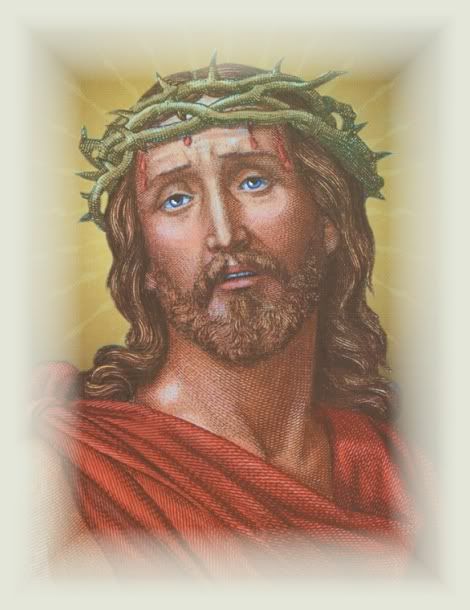
Devotions for a Lenten Wednesday holy hour:
Dies Irae
Divine Mercy Chaplet
Seven Penitential Psalms & the prayers against the Seven Deadly Sins
Prayer of St. Thomas More
Threnus Prayer
Seven Prayers of St. Gregory

Devotions for a Lenten Wednesday holy hour:
Dies Irae
Divine Mercy Chaplet
Seven Penitential Psalms & the prayers against the Seven Deadly Sins
Prayer of St. Thomas More
Threnus Prayer
Seven Prayers of St. Gregory
Labels: Restorationists
Tuesday, February 19, 2008
Castro Resigns
Much remains to be done before we can say that Communist oppression in Cuba is over. But this is a step in that direction. May the Cuban people regain their liberty, and overthrow the regime of forced and unnatural equality that has been oppressing them since 1959. The former East Germany, the former Czechoslovakia, Poland, Hungary, Rumania, Bulgaria, Estonia, the former Yugoslavia, Latvia, Lithuania, and even Russia have done it.
Cuba should follow suit. Then Venezuala should forestall the oppression that is coming its way by deposing the evil clown Chavez.
Oh for the day when Castro, Communist butchering murderer of tens, if not hundreds, of thousands, will stand trial for his crimes against humanity!
Cuba should follow suit. Then Venezuala should forestall the oppression that is coming its way by deposing the evil clown Chavez.
Oh for the day when Castro, Communist butchering murderer of tens, if not hundreds, of thousands, will stand trial for his crimes against humanity!
Labels: American Patriotism Is Not A Sin
Some Suggestions For Lenten Reading
For many years, I struggled with those little booklets many priests publish every year, with daily reflections for the Lenten season. I found them either oh-so-trendy, or so lightweight, that I groaned in need of something more substantial. In the last few years, I have been fortunate enough to find more substantial fare for Lenten reading, all of which I heartily recommend.
The Dolorous Passion Of Our Lord Jesus Christ, by Blessed Anna Catherine Emmerich
The School Of Jesus Crucified, by Father Ignatius Of the Side of Jesus
The Agony Of Jesus, by Saint Pio of Pietrelcina
The Passion and Death of Jesus Christ, by Saint Alphonsus Liguori
The Way of the Cross, by Saint Alphonsus Liguori
The Sermons For Lent, by Saint Francis de Sales
The Seven Last Words Of Christ From the Cross, by Father Christopher Rengers
Saints And Sinners Of Calvary, by Father Christopher Rengers
A Doctor At Calvary, by Pierre Barbet, MD
The Crucified, by Father Alfred O'Rahilly
The Spirit Of Penance: Path To God, by Dom Hubert Van Zeller
The Sinner's Guide, by Ven. Louis of Grenada
A Familiar Exposition Of the Seven Penitential Psalms, by Saint John Fisher
The Foot Of the Cross, by Father Frederick W. Faber
The Dolorous Passion Of Our Lord Jesus Christ, by Blessed Anna Catherine Emmerich
The School Of Jesus Crucified, by Father Ignatius Of the Side of Jesus
The Agony Of Jesus, by Saint Pio of Pietrelcina
The Passion and Death of Jesus Christ, by Saint Alphonsus Liguori
The Way of the Cross, by Saint Alphonsus Liguori
The Sermons For Lent, by Saint Francis de Sales
The Seven Last Words Of Christ From the Cross, by Father Christopher Rengers
Saints And Sinners Of Calvary, by Father Christopher Rengers
A Doctor At Calvary, by Pierre Barbet, MD
The Crucified, by Father Alfred O'Rahilly
The Spirit Of Penance: Path To God, by Dom Hubert Van Zeller
The Sinner's Guide, by Ven. Louis of Grenada
A Familiar Exposition Of the Seven Penitential Psalms, by Saint John Fisher
The Foot Of the Cross, by Father Frederick W. Faber
Labels: Restorationists
More Images Of One Of My Favorite Crucifixes
The crucifix at St. Peter's Church, in Harper's Ferry, VA. It has become a subject of pilgrimage by many of the faithful. St. Peter's Church itself is closed, although Mass may still be offered there occasionally, through the parish it was merged into.
For myself, I would love to see a more open and active environment for this Crucifix. I would love to see a whole Calvary group carved to match it, with a background painted, like the one in the Rood Loft at St. Mary's in New Britain, CT.
And while we are on the topic of ideal locations, would that it could be permanently united to the wonderful Ecce Homo statue of Jesus Scourged, which travels through various Pennsylvania churches. This Lent, the statue can be seen at St. Ignatius of Antioch parish, at 999 Reading Avenue, Yardley PA.
Well, here is another pic of this lovely crucifix.
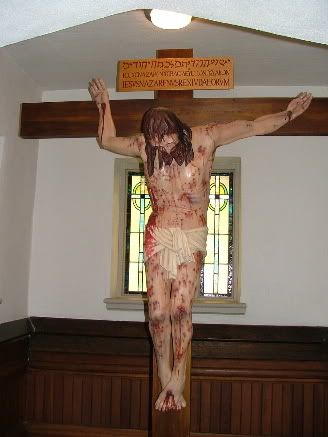
Of course, the Crucifix does not change. But the background and lighting make a difference.
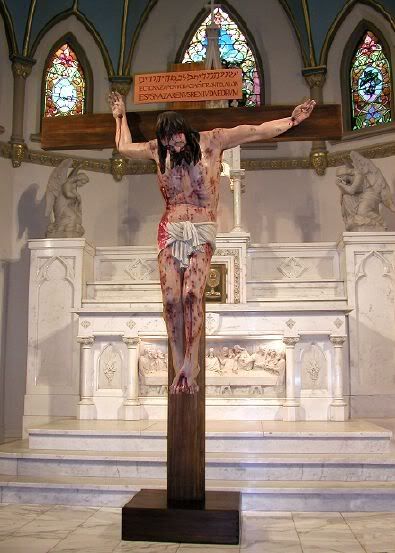
Here is a close-up of Pilate's sign:
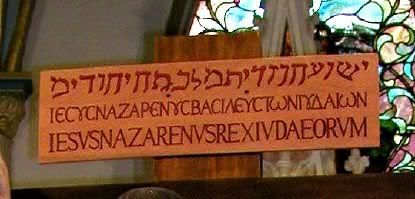
And here is the version of this Crucifix that I pasted into my personal prayerbook, for my morning prayer, opposite the Indulgenced Prayer Before a Crucifix:
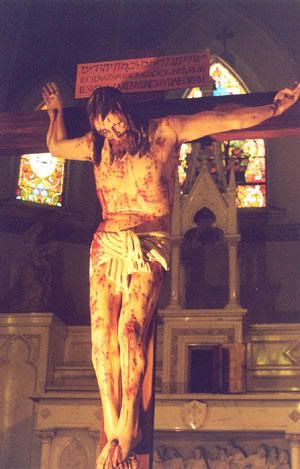
See what I mean about background and lighting making a big difference?
And here is the statue of Jesus Scourged that I think ought to be given a permanent home with the Crucifix:
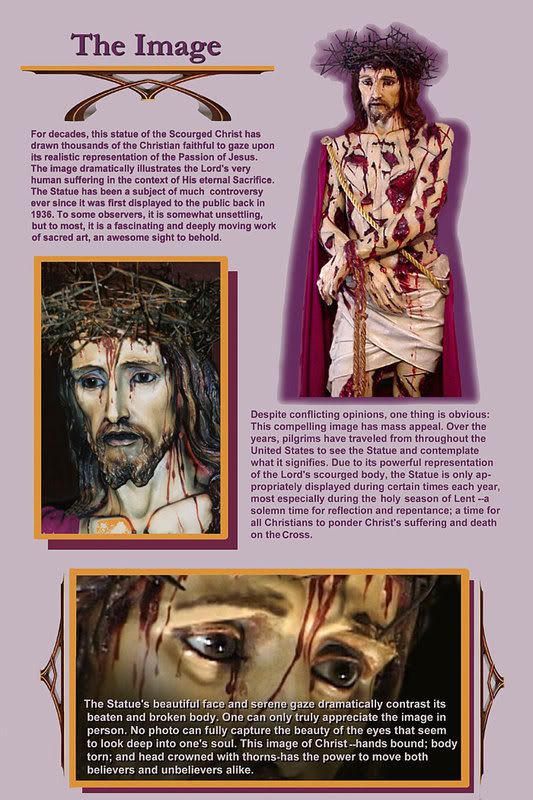
For myself, I would love to see a more open and active environment for this Crucifix. I would love to see a whole Calvary group carved to match it, with a background painted, like the one in the Rood Loft at St. Mary's in New Britain, CT.
And while we are on the topic of ideal locations, would that it could be permanently united to the wonderful Ecce Homo statue of Jesus Scourged, which travels through various Pennsylvania churches. This Lent, the statue can be seen at St. Ignatius of Antioch parish, at 999 Reading Avenue, Yardley PA.
Well, here is another pic of this lovely crucifix.

Of course, the Crucifix does not change. But the background and lighting make a difference.

Here is a close-up of Pilate's sign:

And here is the version of this Crucifix that I pasted into my personal prayerbook, for my morning prayer, opposite the Indulgenced Prayer Before a Crucifix:

See what I mean about background and lighting making a big difference?
And here is the statue of Jesus Scourged that I think ought to be given a permanent home with the Crucifix:

Labels: Restorationists
Tuesday of the Second Week In Lent
Station Church: S. Balbina all'Aventino
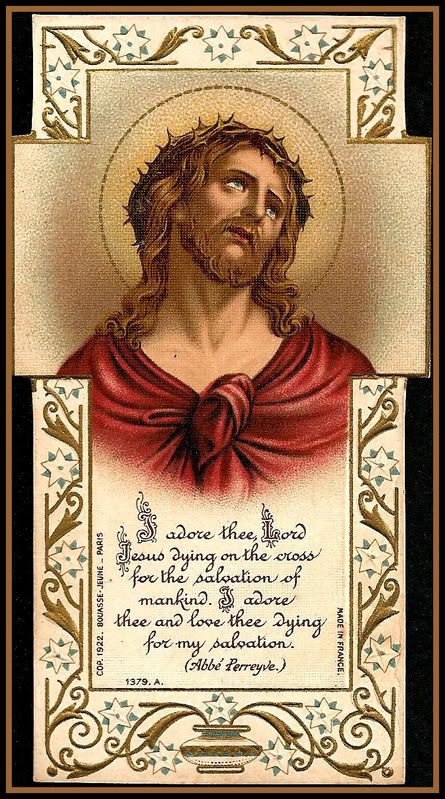
Devotions for a Lenten Tuesday Holy Hour:
Dies Irae
Divine Mercy Chaplet
Seven Penitential Psalms
Prayer of St. Thomas More
Threnus Prayer of Saint Augustine
Devotion of the Seven Last Words

Devotions for a Lenten Tuesday Holy Hour:
Dies Irae
Divine Mercy Chaplet
Seven Penitential Psalms
Prayer of St. Thomas More
Threnus Prayer of Saint Augustine
Devotion of the Seven Last Words
Labels: Restorationists
Monday, February 18, 2008
Monday Of the Second Week In Lent
Station Church: S. Clemente presso il Colosseo
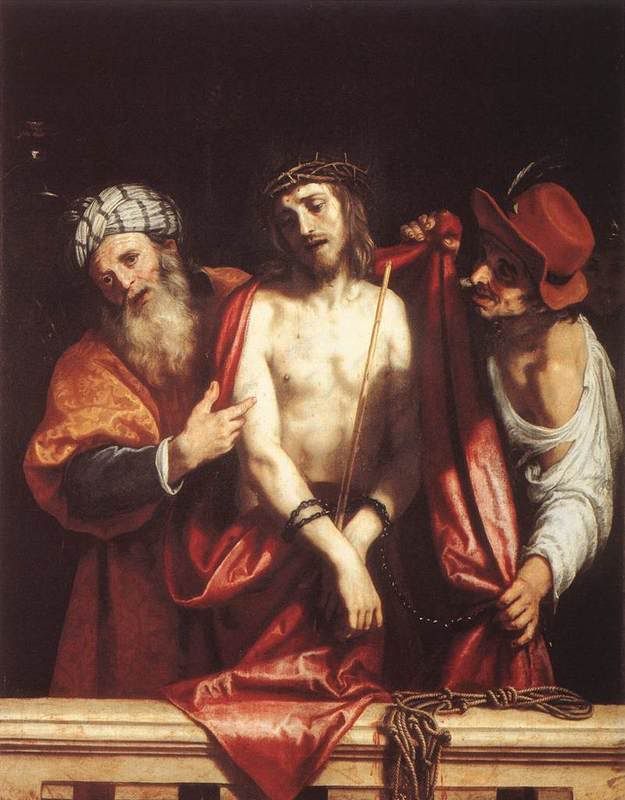
Devotions For A Lenten Monday Holy Hour:
Dies Irae
Divine Mercy Chaplet
Seven Penitential Psalms
Prayer of St. Thomas More
Threnus Prayer of Saint Augustine
Devotion of the Five Sacred Wounds

Devotions For A Lenten Monday Holy Hour:
Dies Irae
Divine Mercy Chaplet
Seven Penitential Psalms
Prayer of St. Thomas More
Threnus Prayer of Saint Augustine
Devotion of the Five Sacred Wounds
Labels: Restorationists
Sunday, February 17, 2008
The Second Sunday In Lent
Station Church: S. Maria in Domenica alla Navicella
Devotions for a Lenten Sunday Holy Hour:
Divine Mercy Chaplet
Seven Penitential Psalms
Prayer of St. Thomas More
Psalter of St. Jerome
Threnus Prayer of St. Augustine
From The Liturgical Year, by Abbot Prosper Gueranger, OSB:
THE subject offered to our consideration, on this second Sunday, is one of the utmost importance for the holy season. The Church applies to us the lesson which our Saviour gave to three of His apostles. Let us endeavour to be more attentive to it than they were.
Jesus was about to pass from Galilee into Judea, that He might go up to Jerusalem and be present at the feast of the Pasch. It was that last Pasch, which was to begin with the immolation of the figurative lamb, and end with the sacrifice of the Lamb of God, who taketh away the sins of the world. Jesus would have His disciples know Him. His works had borne testimony to Him, even before those who were, in a manner, strangers to Him; but as for His disciples, had they not every reason to be faithful to Him, even to death? Had they not listened to His words, which had such power with them that they forced conviction? Had they not experienced His love, which it was impossible to resist? And had they not seen how patiently He had borne with their strange and untoward ways? Yes, they must have known Him. They had heard one of their company, Peter, declare that He was the Christ, the Son of the living God. [St. Matt. xvi. 16.] Notwithstanding this, the trial to which their faith was soon to be put was of such a terrible kind, that Jesus would mercifully arm them against temptation by an extraordinary grace.
The cross was to be a scandal and a stumbling-block [1 Cor. i. 23.] to the Synagogue, and alas! to more than it. Jesus said to His apostles at the last Supper: 'All of you shall be scandalized in Me this night.' [St. Matt. xxvi. 31.] Carnal-minded as they then were, what would they think when they should see Him seized by armed men, handcuffed, hurried from one tribunal to another, and doing nothing to defend Himself! And when they found that the high priests and pharisees, who had hitherto been so often foiled by the wisdom and miracles of Jesus, had now succeeded in their conspiracy against Him, what a shock to their confidence! But there was to be something more trying still: the people, who, but a few days before, greeted Him so enthusiastically with their Hosannas, would demand His execution; and He would have to die, between two thieves, on the cross, amidst the insults of His triumphant enemies.
Is it not to be feared that these disciples, when they witness His humiliations and sufferings, will lose their courage? They have lived in His company for three years; but when they see that the things He foretold would happen to Him are really fulfilled, will the remembrance of all they have seen and heard keep them loyal to Him? Or will they turn cowards and flee from Him? Jesus selects three out of the number, who are especially dear to Him: Peter, whom He has made the rock, on which His Church is to be built, and to whom He has promised the keys of the kingdom of heaven; James, the son of thunder, who is to be the first martyr of the apostolic college; and John, James's brother, and His own beloved disciple. Jesus has resolved to take them aside, and show them a glimpse of that glory, which, until the day fixed for its manifestation, He conceals from the eyes of mortals.
He therefore leaves the rest of His disciples in the plain near Nazareth, and goes in company with the three privileged ones towards a high hill called Thabor, which is a continuation of Libanus, and which the psalmist tells us was to rejoice in the name of the Lord. [Ps. lxxxviii. 13.] No sooner has He reached the summit of the mountain, than the three apostles observe a sudden change come over Him; His Face shines as the sun, and His humble garments become white as snow. They observe two venerable men approach and speak with Him upon what He is about to suffer in Jerusalem. One is Moses, the lawgiver; the other is Elias, the prophet, who was taken up from earth on a fiery chariot without having passed through the gates of death. These two great representatives of the Jewish religion, the Law and the Prophets, humbly adore Jesus of Nazareth. The three apostles are not only dazzled by the brightness which comes from their divine Master; but they are filled with such a rapture of delight, that they cannot bear the thought of leaving the place. Peter proposes to remain there for ever and build three tabernacles, for Jesus, Moses, and Elias. And while they are admiring the glorious sight, and gazing on the beauty of their Jesus' human Nature, a bright cloud overshadows them, and a voice is heard speaking to them: it is the voice of the eternal Father, proclaiming the Divinity of Jesus, and saying: 'This is My beloved Son!'
This transfiguration of the Son of Man, this manifestation of His glory, lasted but a few moments: His mission was not on Thabor; it was humiliation and suffering in Jerusalem. He therefore withdrew into Himself the brightness He had allowed to transpire; and when He came to the three apostles, who, on hearing the voice from the cloud, had fallen on their faces with fear, they could see no one save only Jesus. The bright cloud was gone; Moses and Elias had disappeared. What a favour they have had bestowed upon them! Will they remember what they have seen and heard? They have had such a revelation of the Divinity of their dear Master! Is it possible that, when the hour of trial comes, they will forget it, and doubt His being God? And when they see Him suffer and die, will they be ashamed of Him and deny Him? Alas! the Gospel has told us what happened to them.
A short time after this, our Lord celebrated His last Supper with His disciples. When the supper was over, He took them to another mount, Mount Olivet, which lies to the east of Jerusalem. Leaving the rest at the entrance of the garden, He advances with Peter, James, and John, and then says to them: 'My soul is sorrowful even unto death: stay you here and watch with Me.' [St. Matt. xxvi. 38.] He then retires some little distance from them, and prays to His eternal Father. The Heart of our Redeemer is weighed down with anguish. When He returns to His three disciples, He is enfeebled by the agony He has suffered, and His garments are saturated with Blood. The apostles are aware that He is sad even unto death, and that the hour is close at hand when He is to be attacked: are they keeping watch? are they ready to defend Him? No: they seem to have forgotten Him; they are fast asleep, for their eyes are heavy. [Ibid. 43.] Yet a few moments, and all will have fled from Him; and Peter, the bravest of them all, will be taking his oath that he never knew the Man.
After the Resurrection our three apostles made ample atonement for this cowardly and sinful conduct, and acknowledged the mercy wherewith Jesus had sought to fortify them against temptation, by showing them His glory on Thabor a few days before His Passion. Let us not wait till we have betrayed Him: let us at once acknowledge that He is our Lord and our God. We are soon to be keeping the anniversary of His Sacrifice; like the apostles, we are to see Him humbled by His enemies and bearing, in our stead, the chastisements of divine justice. We must not allow our faith to be weakened, when we behold the fulfilment of those prophecies of David and Isaias, that the Messias is to be treated as a worm of the earth, [Ps. xxi. 7.] and be covered with wounds, so as to become like a leper, the most abject of men, and the Man of sorrows. [Is. liii. 3. 4.] We must remember the grand things of Thabor, and the adorations paid Him by Moses and Elias, and the bright cloud, and the voice of the eternal Father. The more we see Him humbled, the more must we proclaim His glory and divinity; we, must join our acclamations with those of the angels and the four-and-twenty elders, whom St. John, one of the witnesses of the Transfiguration, heard crying out with a loud voice: 'The Lamb that was slain, is worthy to receive power and divinity, and wisdom, and strength, and honour, and glory, and benediction!' [Apoc. v. 12.]
The second Sunday of Lent is called, from the first word of the Introit, Reminiscere; and also Transfiguration-Sunday, on account of the Gospel which is read in the Mass.
The Station at Rome is in the church of St. Mary in Dominica, on Monte Celio. Tradition tells us that in this basilica was the diaconicum of which St. Laurence had charge, and from which he distributed to the poor the alms of the Church.
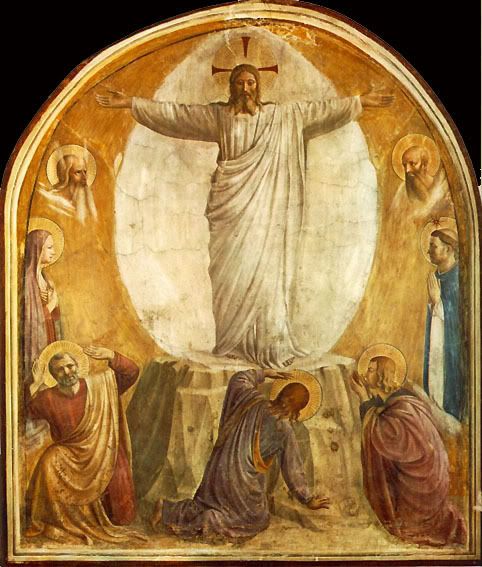
Devotions for a Lenten Sunday Holy Hour:
Divine Mercy Chaplet
Seven Penitential Psalms
Prayer of St. Thomas More
Psalter of St. Jerome
Threnus Prayer of St. Augustine
From The Liturgical Year, by Abbot Prosper Gueranger, OSB:
THE subject offered to our consideration, on this second Sunday, is one of the utmost importance for the holy season. The Church applies to us the lesson which our Saviour gave to three of His apostles. Let us endeavour to be more attentive to it than they were.
Jesus was about to pass from Galilee into Judea, that He might go up to Jerusalem and be present at the feast of the Pasch. It was that last Pasch, which was to begin with the immolation of the figurative lamb, and end with the sacrifice of the Lamb of God, who taketh away the sins of the world. Jesus would have His disciples know Him. His works had borne testimony to Him, even before those who were, in a manner, strangers to Him; but as for His disciples, had they not every reason to be faithful to Him, even to death? Had they not listened to His words, which had such power with them that they forced conviction? Had they not experienced His love, which it was impossible to resist? And had they not seen how patiently He had borne with their strange and untoward ways? Yes, they must have known Him. They had heard one of their company, Peter, declare that He was the Christ, the Son of the living God. [St. Matt. xvi. 16.] Notwithstanding this, the trial to which their faith was soon to be put was of such a terrible kind, that Jesus would mercifully arm them against temptation by an extraordinary grace.
The cross was to be a scandal and a stumbling-block [1 Cor. i. 23.] to the Synagogue, and alas! to more than it. Jesus said to His apostles at the last Supper: 'All of you shall be scandalized in Me this night.' [St. Matt. xxvi. 31.] Carnal-minded as they then were, what would they think when they should see Him seized by armed men, handcuffed, hurried from one tribunal to another, and doing nothing to defend Himself! And when they found that the high priests and pharisees, who had hitherto been so often foiled by the wisdom and miracles of Jesus, had now succeeded in their conspiracy against Him, what a shock to their confidence! But there was to be something more trying still: the people, who, but a few days before, greeted Him so enthusiastically with their Hosannas, would demand His execution; and He would have to die, between two thieves, on the cross, amidst the insults of His triumphant enemies.
Is it not to be feared that these disciples, when they witness His humiliations and sufferings, will lose their courage? They have lived in His company for three years; but when they see that the things He foretold would happen to Him are really fulfilled, will the remembrance of all they have seen and heard keep them loyal to Him? Or will they turn cowards and flee from Him? Jesus selects three out of the number, who are especially dear to Him: Peter, whom He has made the rock, on which His Church is to be built, and to whom He has promised the keys of the kingdom of heaven; James, the son of thunder, who is to be the first martyr of the apostolic college; and John, James's brother, and His own beloved disciple. Jesus has resolved to take them aside, and show them a glimpse of that glory, which, until the day fixed for its manifestation, He conceals from the eyes of mortals.
He therefore leaves the rest of His disciples in the plain near Nazareth, and goes in company with the three privileged ones towards a high hill called Thabor, which is a continuation of Libanus, and which the psalmist tells us was to rejoice in the name of the Lord. [Ps. lxxxviii. 13.] No sooner has He reached the summit of the mountain, than the three apostles observe a sudden change come over Him; His Face shines as the sun, and His humble garments become white as snow. They observe two venerable men approach and speak with Him upon what He is about to suffer in Jerusalem. One is Moses, the lawgiver; the other is Elias, the prophet, who was taken up from earth on a fiery chariot without having passed through the gates of death. These two great representatives of the Jewish religion, the Law and the Prophets, humbly adore Jesus of Nazareth. The three apostles are not only dazzled by the brightness which comes from their divine Master; but they are filled with such a rapture of delight, that they cannot bear the thought of leaving the place. Peter proposes to remain there for ever and build three tabernacles, for Jesus, Moses, and Elias. And while they are admiring the glorious sight, and gazing on the beauty of their Jesus' human Nature, a bright cloud overshadows them, and a voice is heard speaking to them: it is the voice of the eternal Father, proclaiming the Divinity of Jesus, and saying: 'This is My beloved Son!'
This transfiguration of the Son of Man, this manifestation of His glory, lasted but a few moments: His mission was not on Thabor; it was humiliation and suffering in Jerusalem. He therefore withdrew into Himself the brightness He had allowed to transpire; and when He came to the three apostles, who, on hearing the voice from the cloud, had fallen on their faces with fear, they could see no one save only Jesus. The bright cloud was gone; Moses and Elias had disappeared. What a favour they have had bestowed upon them! Will they remember what they have seen and heard? They have had such a revelation of the Divinity of their dear Master! Is it possible that, when the hour of trial comes, they will forget it, and doubt His being God? And when they see Him suffer and die, will they be ashamed of Him and deny Him? Alas! the Gospel has told us what happened to them.
A short time after this, our Lord celebrated His last Supper with His disciples. When the supper was over, He took them to another mount, Mount Olivet, which lies to the east of Jerusalem. Leaving the rest at the entrance of the garden, He advances with Peter, James, and John, and then says to them: 'My soul is sorrowful even unto death: stay you here and watch with Me.' [St. Matt. xxvi. 38.] He then retires some little distance from them, and prays to His eternal Father. The Heart of our Redeemer is weighed down with anguish. When He returns to His three disciples, He is enfeebled by the agony He has suffered, and His garments are saturated with Blood. The apostles are aware that He is sad even unto death, and that the hour is close at hand when He is to be attacked: are they keeping watch? are they ready to defend Him? No: they seem to have forgotten Him; they are fast asleep, for their eyes are heavy. [Ibid. 43.] Yet a few moments, and all will have fled from Him; and Peter, the bravest of them all, will be taking his oath that he never knew the Man.
After the Resurrection our three apostles made ample atonement for this cowardly and sinful conduct, and acknowledged the mercy wherewith Jesus had sought to fortify them against temptation, by showing them His glory on Thabor a few days before His Passion. Let us not wait till we have betrayed Him: let us at once acknowledge that He is our Lord and our God. We are soon to be keeping the anniversary of His Sacrifice; like the apostles, we are to see Him humbled by His enemies and bearing, in our stead, the chastisements of divine justice. We must not allow our faith to be weakened, when we behold the fulfilment of those prophecies of David and Isaias, that the Messias is to be treated as a worm of the earth, [Ps. xxi. 7.] and be covered with wounds, so as to become like a leper, the most abject of men, and the Man of sorrows. [Is. liii. 3. 4.] We must remember the grand things of Thabor, and the adorations paid Him by Moses and Elias, and the bright cloud, and the voice of the eternal Father. The more we see Him humbled, the more must we proclaim His glory and divinity; we, must join our acclamations with those of the angels and the four-and-twenty elders, whom St. John, one of the witnesses of the Transfiguration, heard crying out with a loud voice: 'The Lamb that was slain, is worthy to receive power and divinity, and wisdom, and strength, and honour, and glory, and benediction!' [Apoc. v. 12.]
The second Sunday of Lent is called, from the first word of the Introit, Reminiscere; and also Transfiguration-Sunday, on account of the Gospel which is read in the Mass.
The Station at Rome is in the church of St. Mary in Dominica, on Monte Celio. Tradition tells us that in this basilica was the diaconicum of which St. Laurence had charge, and from which he distributed to the poor the alms of the Church.

Labels: Restorationists


